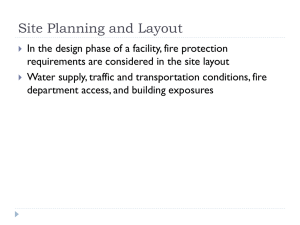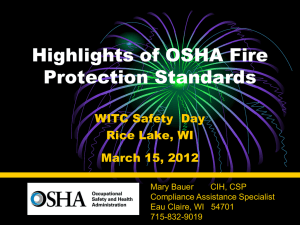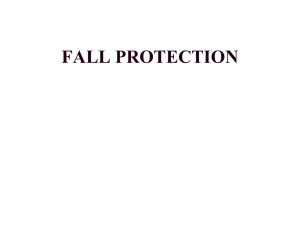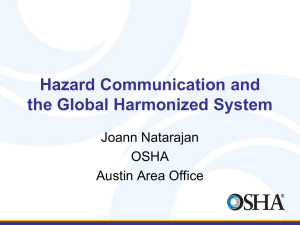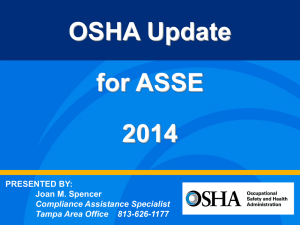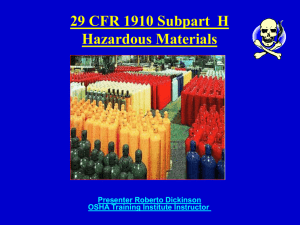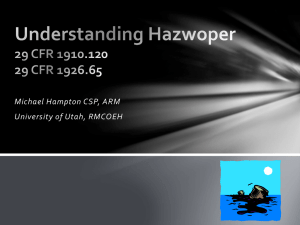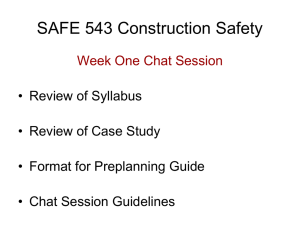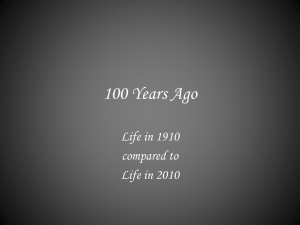Revised Hazard Communication Handout 2012
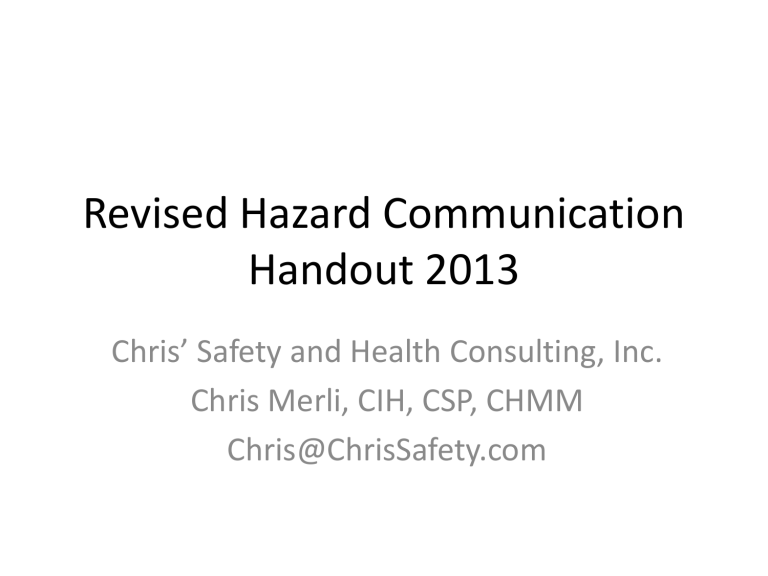
Revised Hazard Communication
Handout 2013
Chris’ Safety and Health Consulting, Inc.
Chris Merli, CIH, CSP, CHMM
Chris@ChrisSafety.com
Training Action Items
1. Ensure a system is available to identify new hazards requiring additional training
2. Ensure employees understand hazards and controls
3. Evaluate effectiveness of training
A. Level 2 – Change in knowledge/skills/attitude
B. Level 3 – Transfer to workplace
4. Ensure robust training recordkeeping
2
Hazard Class
Acute Toxicity
Skin Corrosion/ Irritation
Serious Eye Damage/ Eye Irritation
Respiratory or Skin Sensitization
Germ Cell Mutagenicity
Carcinogenicity
Reproductive Toxicity
STOT – Single Exposure
STOT – Repeated Exposure
Aspiration
Simple Asphyxiants
Health Hazards
Hazard Category
2 3 1
1A
1
1
1A
1A
1
1
1A
1
Single Category
1B
2A
1B
1B
1B
2
2
2
3
2
2
1C
2B
4
2
Lactation
Hazard Class
Explosives
Flammable Gases
Flammable Aerosols
Oxidizing Gases
Gases under Pressure
Compressed Gases
Liquefied Gases
Refrigerated Liquefied Gases
Dissolved Gases
Flammable Liquids
Flammable Solids
Self-Reactive Chemicals
Pyrophoric Liquids
Pyrophoric Solid
Pyrophoric Gases
Self-heating Chemicals
Chemicals, which in contact with water, emit flammable gases
Oxidizing Liquids
Oxidizing Solids
Organic Peroxides
Corrosive to Metals
Combustible Dusts
Physical Hazards
Hazard Category
Div 1.2
Div 1.3
Div 1.4
Unstable Explosives
1
1
1
Div 1.1
2
2
1
1
1
Type A
1
1
Single category
1
1
1
1
Type A
1
Single category
2
2
Type B
2
2
2
2
Type B
3
Type C
3
3
3
Type C
4
Type D
Type D
Type E
Type E
Div 1.5
Div 1.6
Type F
Type F
Type G
Type G
HCS Pictograms and Hazards
Label Example
16-Section Safety Data Sheet
1.
Identification of the substance or mixture and of the supplier
2.
Hazards identification
3.
Composition/information on ingredients Substance/Mixture
4.
First aid measures
5.
Firefighting measures
6.
Accidental release measures
7.
Handling and storage
8.
Exposure controls/personal protection
9.
Physical and chemical properties
10. Stability and reactivity
11. Toxicological
12. Ecological information
(non mandatory)
13. Disposal considerations
(non mandatory)
14. Transport information
(non mandatory)
15. Regulatory information
(non mandatory)
16. Other information including information on preparation and revision of the SDS
j) Effective Dates – HazCom 2012
Effective Completion Date
December 1, 2013
June 1, 2015*
December 1, 2015
June 1, 2016
Transition Period
Requirement(s)
Train employees on the new label elements and SDS format.
Comply with all modified provisions of this final rule, except:
Who
Employers
Distributors may ship products labeled by manufacturers under the old system until December 1,
2015.
Update alternative workplace labeling and hazard communication program as necessary, and provide additional employee training for newly identified physical or health hazards.
Comply with either 29 CFR 1910.1200 (this final standard), or the current standard, or both
Chemical manufacturers, importers, distributors and employers
Employers
All chemical manufacturers, importers, distributors and employers
*This date coincides with the European Union implementation date for classification of mixtures.
Health Standards
• Asbestos (1910.1001; 1926.1101;
1915.1001)
• Acrylonitrile (1910.1045)
• Ethylene Oxide (1910.1047)
•
•
•
13 Carcinogens (1910.1003)
Vinyl Chloride (1910.1017)
Inorganic Arsenic (1910.1018)
• Formaldehyde (1910.1048)
• Methylenedianiline (1910.1050;
1926.60)
• 1,3-Butadiene (1910.1051) • Lead (1910.1025; 1926.62)
•
• Chromium (VI) (1910.1026; 1926.1126; • Methylene Chloride (1910.1052)
1915.1026)
Cadmium (1910.1027; 1926.1127)
• Occupational exposure to hazardous chemicals in laboratories (1910.1450)
• Benzene (1910.1028)
• Coke Oven Emissions (1910.1029)
• Cotton Dust (1910.1043)
• 1,2-dibromo-3-chloropropane
(1910.1044)
Substance-Specific Health Standards
Example - Asbestos
Standard Substance
1910.1001
1915.1001
Asbestos
Regulated areas
Where the use of respirators and protected clothing is required
Original signs
DANGER
ASBESTOS
CANCER AND LUNG
DISEASE HAZARD
AUTHORIZED
PERSONNEL ONLY
RESPIRATORS AND
PROTECTIVE CLOTHING
ARE REQUIRED
IN THIS AREA
Final Changes
DANGER
ASBESTOS
MAY CAUSE CANCER
CAUSES DAMAGE TO LUNGS
AUTHORIZED
PERSONNEL ONLY
WEAR RESPIRATORY PROTECTION AND
PROTECTIVE CLOTHING
IN THIS AREA
Safety Standards
• Flammable Liquids (1910.106; 1926.152)
• Spray finishing using flammable and combustible materials (1910.107)
• Process safety management of highly hazardous chemicals (1910.119; 1926.64)
• Hazardous waste operations and emergency response (1910.120; 1926.65)
• Dipping and coating operations: Coverage and definitions (1910.123)
• General requirements for dipping and coating operations (1910.124)
• Additional requirements for dipping and coating operations that use flammable liquids or liquids with flashpoints greater than 199.4 °F (93 °C) (1910.125)
• Welding, Cutting, and Brazing (1910.252)
Revision of 29 CFR 1910.106 Flammable
Liquids
Flammable 1
Flammable 2
Flammable 3
None
Category
Flammable 4
Revised HazCom
Flashpoint
º
C (°F)
< 23 (73.4)
< 23 (73.4)
≥ 23 (73.4) and ≤
60 (140)
> 60 (140) and ≤93
(199.4)
Flammable and Combustible Liquids Standard
(29 CFR 1910.106)
Class Flashpoint
º
C (°F) Boiling
Point
º
C (°F)
≤ 35 (95)
Flammable Class IA
> 35 (95) Flammable Class IB
Flammable Class IC
Combustible Class II
< 22.8 (73)
< 22.8 (73)
≥ 22.8 (73) and < 37.8
(100)
≥ 37.8 (100) and < 60
(140)
Boiling Point
º
C (°F)
< 37.8 (100)
≥ 37.8 (100)
Combustible Class IIIA ≥ 60 (140) and <93.3
(200)
Combustible Class IIIB
≥ 93.3 (200)
Safety Standards
PSM 1910.119(a)(1)(ii)
HazCom 1994
• A process which involves a flammable liquid or gas (as defined in 1910.1200(c) of this part) on site in one location, in a quantity of
10,000 pounds (4535.9 kg) or more except for:
HazCom 2012
• A process which involves a
Category 1 flammable gas
(as defined in 1910.1200
(c)) or a flammable liquid with a flashpoint below 100
°F (37.8 °C) on site in one location, in a quantity of
10,000 pounds (4535.9 kg) or more except for:
Updated HazCom Web Page
OSHA Guidance & Outreach
Highlights
• HCS/HazCom Final Rule
» Federal Register: The Final Rule was filed on March
20th at the Office of the Federal Register and available for viewing on their Public Electronic Inspection Desk.
The Federal Register published the final rule on March
26, 2012. The effective date of the final rule is 60 days after the date of publication.
• HCS Comparison: HazCom 1994 and Hazcom
2012
» Side-by-side
» Redline Strikeout of the Regulatory Text
OSHA Guidance & Outreach
OSHA Guidance & Outreach
• Press Release: US Department of Labor's OSHA publishes final rule to update the Hazard
Communication Standard (HCS)
• Guidance
» OSHA Briefs
» Fact Sheet
» Quick Cards
OSHA Directorate of Enforcement
Programs: Products
• Letters of Interpretation
» Provide guidance on specific sections of the standard.
» Where appropriate, will be incorporated into the directive.
• Hazard Communication Directive
» Provides guidance on how OSHA enforces the
Hazard Communication Standard.
Hazard Communication Directive
• CPL 02-02-038 Inspection Procedures for HCS
• Provides an outline to compliance officers of what to review and how to cite HazCom violations
• Covers sections of the standard and provides clarification on how the individual subparts should be reviewed and enforced.
OSHA Guidance & Outreach
OSHA is developing an array of guidance materials
• Initial Materials
» Quick cards, OSHA briefs, booklets, small entity compliance guides
• Technical Materials
» Model training materials; Safety Data Preparation guidance; Hazard Classification Guidance
• Web Applications
» SDS Electronic Form; Label Elements Application;
Acute Toxicity Calculator
Updated OSHA Webpages
• HazCom 2012 Webpage
» http://www.osha.gov/dsg/hazcom/index.html
• Safety & Health Topics Webpage
» http://www.osha.gov/dsg/hazcom/index2.html
Updated Webpages
• HazCom 2012 Webpage http://www.osha.gov/dsg/hazcom/index.html
• Safety & Health Topics Webpage http://www.osha.gov/dsg/hazcom/index2.html
• UN GHS Sub-Committee Home Page http://www.unece.org/trans/danger/publi/ghs/ghs_ welcome_e.html
ANSI Guidance & Outreach
• ANSI Z129.1-Hazardous Industrial
Chemicals-Precautionary Labeling
• ANSI Z400.1-Hazardous Industrial
Chemicals-Material Safety Data Sheets-
Preparation
• www.ansi.org
23
Guidance & Outreach
• www.schc.org
- Society for Chemical Hazard
Communication: GHS Information Sheets and coursework
• www.cdc.gov/niosh
– NIOSH Pocket Guide to Chemical Hazards (mini-
Safety Data Sheets)
• Publication No. 2005-151 (CD-ROM)
• cdcinfo@cdc.gov
– NIOSH Hazard Communication Self-Inspection
Checklist
UN GHS Guidance & Outreach
• United Nations
Economic Commission for Europe GHS Subcommittee
• http://www.unece.org/t rans/danger/publi/ghs/g hs_welcome_e.html
